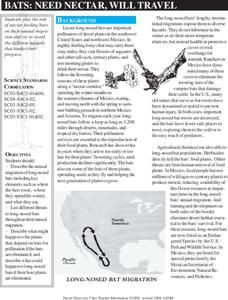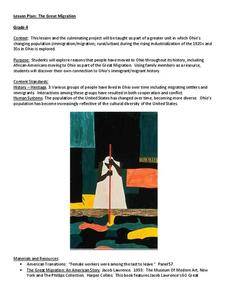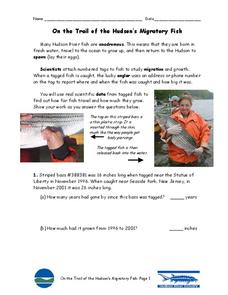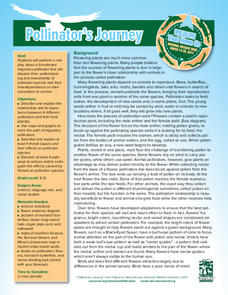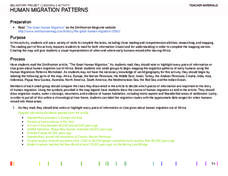SeaWorld
Animal Migrations
Here is a fabulous set of activities for your young scientists. Each instructional activity contains map, hands-on, and game activities that will help the class understand why and how animals migrate from one place to another. First...
Curated OER
Observing the Changes: The Warming of the North
After reviewing the causes and effects of climate change, students become observers for "Plant Watch," a program to monitor the effects of climate change on plants. Students record blooming and leafing dates for selected local species...
Curated OER
It's All About Vitamins
The fascinating topic of human skin color is examined in this article from Muse magazine. It highlights a study done by a pair of scientists on the relationships among strength of sunlight, vitamins, and melanin in the skin. The results...
Curated OER
Bats: Need Nectar, Will Travel
Beginning wildlife biologists become adult bats, baby bats, snakes, owls, bobcats, or land-clearing developers in a grand role-playing activity. In a large open space, they play a game in which they move to designated areas based on what...
Curated OER
Regents High School Examination: Living Environment 2010
This exam touches upon every topic within the typical first year biology course.. A broad variety of question styles give high schoolers every opportunity to show what they know. Why start from scratch when a comprehensive final exam is...
Curated OER
California's Golden History: 1848-1880
Using a variety of online resources, learners study life and society in California during the gold rush. They use a map to identify area where gold was located, explore pre-selected websites, describe mining practices, and create an...
Curated OER
The Great Migration
What a terrific instructional activity! Have your class learn about immigration using this resource. Fourth graders discuss the Great Migration in Ohio through art, writing, and discussion. Afterward, they create a presentation in which...
Curated OER
On the Trail of the Hudson's Migratory Fish
Ever wonder how scientists track fish underwater? Your class can learn how with this informative worksheet. First, they will read a paragraph about androgynous fish, tagging, and data analysis. Then, your scientists must answer five...
National Endowment for the Humanities
“The Great Migration” by Minnie Bruce Pratt
Minnie Bruce Pratt's poem, "The Great Migration," offers young scholars an opportunity to reflect on how where we come from influences who we are. Groups conduct a close reading of the poem, recording observations about the poem's...
US Department of Commerce
Community Change
America is a country on the move. Analyzing data from the Census Bureau, class members gauge the people moving in and out of their areas. An interactive web feature allows pupils to see who is moving out and moving in, while discussion...
National Wildlife Federation
Pollinator's Journey: Grades 9-12
Gain a deeper understanding of migratory pollinators. After studying about pollinators and their effects on flowering plants, learners hear a story about the migration of Monarch butterflies and bats in the Sonoma Desert. Small groups...
National Wildlife Federation
Pollinator's Journey: Grades 5-8
Re-enact the flight of the pollinator. Pupils learn about the roles of butterflies, bats, and other pollinators in plant reproduction. The class acts out the migratory flight of Monarch butterflies and bats from the Sonoran Desert to...
National Wildlife Federation
Fish and Ladders: Grades 9-12
Swim with the big fish. Using a similar simulation as Fish and Ladders: Grade 5-8, pupils model the migration of Chinook salmon. A large group of the learners play the role of fish, while others are fishers, predators, and hazards....
National Wildlife Federation
Fish and Ladders: Grades 5-8
Swim with the fishes. Learners simulate the migration of Chinook salmon. Groups pretend to be salmon, while others are predators, fishers, and hazards. The salmon start in the spawning area and swim downstream to the ocean until reaching...
National Wildlife Federation
Massive Migrations: Grades K-8
Migratory animals follow the same path every year. Learners research the path of an assigned species and create a map highlighting key landmarks along the way. As a group, they come up with a presentation to share with their class.
National Wildlife Federation
Massive Migrations: Grades K-4
Bird migration is a fascinating behavior. Budding scientists experience their own migrations using the school grounds for their flight patterns. They follow a map that leads them through a migration pattern that includes stops for...
Alabama Wildlife Federation
Butterflies without Borders
Some living things go to extreme measures to avoid the cold. A three-part activity guides learners through the migration of the monarch butterfly. After studying the life cycle of the monarch butterfly, pupils learn the process of...
National Wildlife Federation
Pollinator's Journey: Grades K-4
Mimic the struggle of migratory pollinators. Pupils learn about the threats to pollinator species. They go on to enact a play demonstrating the hazards migratory pollinators experience. To finish, individuals complete a chosen assessment...
Big History Project
Human Migration Patterns II
While humans have always been on the move, the period between 1400 and 1800 saw vast migrations of people between the East and the West. These migrations—whether through slavery or a desire to colonize new lands—shaped the modern world....
Big History Project
Human Migration Patterns
Humans have been on the move for millennia. Using an article from The Smithsonian, pupils chart human movement before written history on a world map. In addition, they examine the modes of transportation used by different waves of human...
College Board
2017 AP® World History Free-Response Questions
Religion and politics have a complicated history. How were they intertwined with wealth in Europe and Asia in the Middle Ages? Learners explore the question using a prompt based on primary sources. Other activities allow individuals to...
College Board
2008 AP® Human Geography Free-Response Questions
Interpreting demographics is no easy task. From the reason more girls go to school around the world to why people move within their own countries, the issues are complex. Short-answer prompts help learners unravel the questions as well...
California Academy of Science
Using Empirical Data in the Classroom: Raptor Migrations!
Raptor flight patterns align with seasonal changes in net primary productivity. Here is a thought-provoking lesson that uses empirical data from a video to help scholars understand raptor migrations, producers/consumers, and ecosystems....
Constitutional Rights Foundation
Educating About Immigration The DREAM Act
Group members role play state legislators, supporters of and opponents to the The DREAM Act (Development, Relief, and Education for Alien Minors). After listening to the arguments put forth for and against the immigration legislation,...





